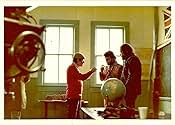Ajouter une intrigue dans votre langueIn the 1930's, Max Brown is an urban young man from an Eastern province, fresh from college, whose only job offer is in a one-room school house in the Canadian prairie. At first he's distant... Tout lireIn the 1930's, Max Brown is an urban young man from an Eastern province, fresh from college, whose only job offer is in a one-room school house in the Canadian prairie. At first he's distant, superior, lonely, and bewildered; his students are rebellious. Over the course of the ye... Tout lireIn the 1930's, Max Brown is an urban young man from an Eastern province, fresh from college, whose only job offer is in a one-room school house in the Canadian prairie. At first he's distant, superior, lonely, and bewildered; his students are rebellious. Over the course of the year, he is drawn to Alice Field, the wife of a farmer, in a love that can lead nowhere. But... Tout lire
- Réalisation
- Scénario
- Casting principal
- Récompenses
- 1 victoire et 2 nominations au total
Avis à la une
However the movie lacks strong does not expand on certain issues. For instance, it would have been interesting to know how many persons came out West during the depression. Or how this migration affected the prairies. Providing these details would have made the movie more informative to watch.
VG
In terms of style, I noticed that the people living in U.S. and the Praires during the 30s differed quite a bit. Some of the clothes and hairstyles that the women wore were similar, but the people of the Prairies were "country folk," and dressed more appropriately for their lifestyles. Alice, for example,(played by Samantha Eggar), wore the sleek, wavy, side-parted bob that many women of the era chose to sport. However, the difference in economic status was apparent in her attire. The aprons and plain skirts she wore had less appeal than the more elegant blouses and dresses that other women preferred.
In conclusion, the movie was pretty effective in getting its message out to the audience. Bud Cort proved his acting skills alongside his pupils, and many important issues were discussed with respect to the conditions of the schools at the time, and Mr. Brown's personal experiences with Prairie weather. The movie was humorous, with a bit of drama, and still maintained a fair amount of accuracy in portraying life in the 1930s.
-A. W.
So in other words, this movie is good for a history class that is covering the 1920's-1930's depression because it gives an accurate description of the events in the prairies.
Le saviez-vous
- AnecdotesThe film takes place in 1935.
- Citations
Inspector Wood: This should be an easy one. What is the capital of Canada?
Inspector Wood: [pointing to a student in the classroom] Yes, boy.
Charlie Mc Dougall: [standing to attention] The capital of Canada is C.
- ConnexionsFeatured in Cruel, Usual, Necessary: The Passion of Silvio Narizzano (2024)
Meilleurs choix
Détails
- Date de sortie
- Pays d’origine
- Langue
- Aussi connu sous le nom de
- Zašto da ubijemo učitelja
- Lieux de tournage
- Sociétés de production
- Voir plus de crédits d'entreprise sur IMDbPro
Box-office
- Budget
- 810 000 $CA (estimé)





















